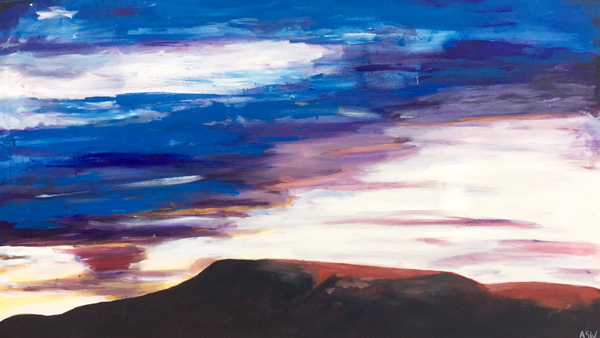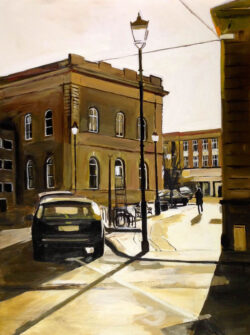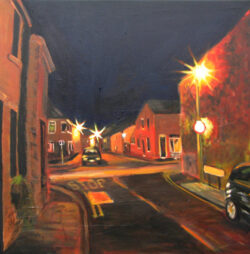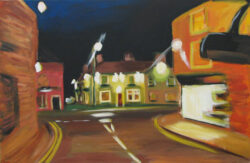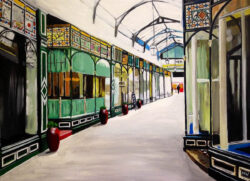Description
An original landscape painting by Angela Wakefield, from earlier in her career, back in 2004. Pendle is one of the most famous landmarks and dominant features of the Ribble Valley Landscape in Lancashire.
There is a mood and tolerance in this early painting by Angela. It is delightful to view as it allows the viewer to test interpretation and composition whilst having at the back of one’s mind the artist’s current output.
“The intensity of light and shade hits immediately. There is a breaking point in that the terrain is cut loose by the sky which is not easily achieved in landscape work. In most landscapes , there seems to be a tendency to want to join up or blend terrain with sky but there is life after Turner. Angela makes the light and shade work by applying the right colours to allow for placing of features. For instance, the break in the cloud brought about by a mix of crimson, grey and blue transforms the plateau behind the foreground peaks or edges. The structure of the painting creates an off-centre vanishing point that seems to drift up and over the distant edges to the left of the canvas. The brightening of the sky perhaps gives us a clue to the decision taken by the artist (the Sun almost certainly being behind the hill) but the funneled effect of the sky just above the horizon on the left gives us another clue albeit a meteorological one. The meteorological term of this kind of cloud formation is “anvil.” A cloud anvil can often be seen high above initial cloud and picked out by sunlight. It is a storm that is launching high into the atmosphere and develops as warm moist air interacts with the cold air drawn down from stratospheric level. Often another effect though not visible in the painting is a “sun-dog” which is basically ice particles reflected by the arc of the sun as we view – the “anvil” acts as a heat shield but rarely stops a storm from forming; and a sun-dog acts as a prismatic temperature gauge.
The mood mentioned at the beginning is intense. Stormy and foreboding. The scene overall brings about an isolation but at the same time, a decision to be at one with nature and all its elements. The intensity of the scene perhaps matches the title – Pendle. Pendle brings together the beautiful and rugged Ribble Valley of Lancashire with Craven and Calderdale of Yorkshire – a localised war of the roses? I traveled through Pendle in 2007 and certainly experienced the challenge of Pendle as far as embracing all that one’s eyes could see. The terrain is breathtaking.
What I like about this painting, as with so many of Angela’s works, is the appreciation of location but the subtle invitation to the viewer to listen! Yes, I said listen. You can hear winter’s call in this painting. You can hear the distant closing of thunder as a storm appears to have passed but another could be following on; but you can also hear your breath as you pant whilst walking.
For an early work, I am seeing in this painting a self imposed apprenticeship by the artist – it wasn’t just about what acrylic could do but how it could create so much more – vibrancy, lifting, three dimensional positive damage. Angela’s paintings and this one is a good example, are not chocolate box landscapes. They are reality paintings – the scenes are exactly as you see them – working and at times, embittered locations that stand out because of functionality or everyday use. Whilst bright lights and urban were waiting patiently in the wings, judging from this early work Angela had already decided that reality was key not quintessential populous.”
Ian Welland, Writer & Historian

